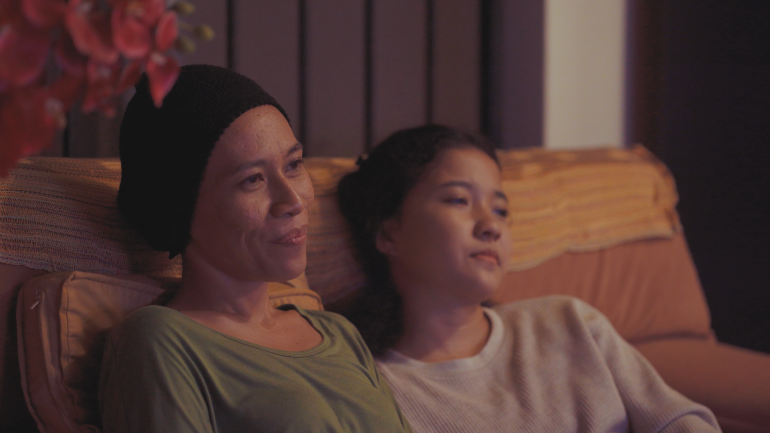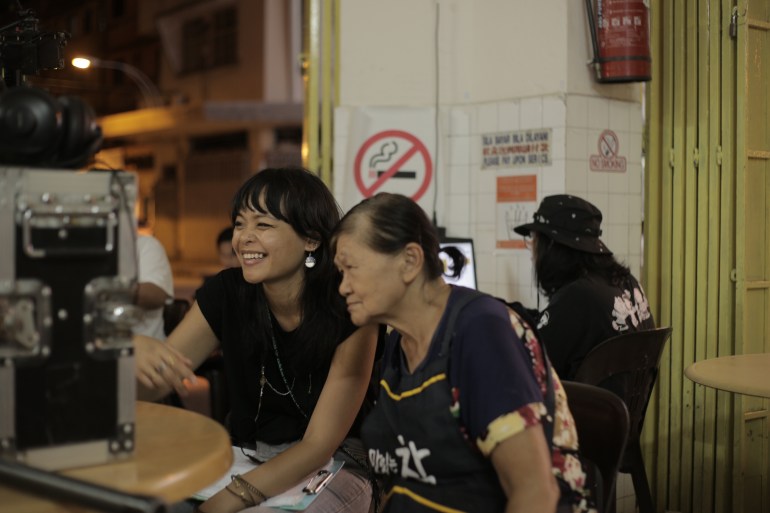Michelle Yeoh’s success masks struggle of Malaysian film industry
Amid ethnic divisions, brain drain and censorship, the Southeast Asian nation lags behind its neighbours in cinematic success.

Malaysian actress Michelle Yeoh made history last month when she became the first Asian to win Best Actress at the Screen Actors Guild Awards, raising hopes she might even take home an Oscar this weekend.
Yeoh’s second accolade for her performance in the indie sci-fi flick Everything Everywhere All At Once (2022) marked another step towards inclusion in the predominantly white and male-dominated Hollywood film industry.
Keep reading
list of 4 itemsIndonesian video-on-demand films take world by storm
Six takeaways from the 2023 Oscar nominations
India secures three nominations at Oscars, including RRR’s song
Back in multi-ethnic Malaysia, the actress’s achievements also triggered a debate on issues of inclusion.
Yeoh, a Malaysian of Chinese origin, got her start in the movie industry in Hong Kong in the 1980s. Other prominent Malaysians in the industry – such as Kuching-born director James Wan, the creator of popular horror films like The Conjuring and Insidious, as well as Malaysian-British actor Henry Golding, the male lead in Jon M Chu’s wildly popular romantic comedy Crazy Rich Asians (2018) – have also found recognition by going overseas.
Like Yeoh, Wan is not part of Malaysia’s ethnic majority, the Malay Muslims, who with Indigenous people are granted a “special position” in the country’s constitution. Golding’s mother, however, is an Indigenous Iban from Borneo.
Small and fractured audience
According to the Malaysian Department of Statistics, 69.9 percent of the 30.2 million Malaysians are Bumiputera, an umbrella term encompassing the Malays and the Indigenous peoples of Peninsular Malaysia as well as the Borneo states of Sabah and Sarawak.
The remainder of the population is 22.8 percent ethnic Chinese and 6.6 percent ethnic Indian. Other minority groups are classified as lain-lain (others) at 0.7 percent.

Malaysia’s diversity and its multiple languages – including Malay, Cantonese and other Chinese dialects, Tamil and indigenous languages – have created a fragmented movie industry and cinema viewership.
An average of 60 feature films and between three and 400 TV dramas and series are shot each year, feeding the country’s 150 cinema screens, local television channels and streaming platforms such as Netflix and HBO.
Because of language, most films usually feature a mono-ethnic cast of actors and appeal to that specific segment of the country’s racial puzzle.
To stimulate the growth of the local film industry, the government in 1981 created the National Film Development Corporation Malaysia (FINAS). The corporation put in place the skim wajib tayang (compulsory screening scheme), which grants most local films a guaranteed national cinematic release of 14 days.
But the country’s ethnic makeup also influences box office success.
Last year, the film Mat Kilau: Kebangkitan Pahlawan (Mat Kilau: The Rise of a Warrior, 2022) by Syamsul Yusof, based on the historical upheaval of Malay patriots like Tok Gajah and Mat Kilau who resisted a tax and revenue law introduced by British colonisers at the end of the 19th century, earned 94 million Malaysian ringgit ($20.8 million) at the box office, becoming the highest-grossing Malaysian film of all time.
In comparison, the highest-grossing Malaysian Mandarin-Chinese-language film was The Journey (2014) by Chiu Keng Guan, which earned 16.87 million ringgit ($3.72 million).
Chiu did not let his country’s small and segmented market restrict his career and started producing Mandarin-language films in China. His sport-themed drama On Your Mark (2021) topped the Chinese box office, earning more than 13.65 million Chinese yuan ($1.96 million) on its opening day and more than 37 million yuan ($5.3 million) over the next two days. This made it the top-grossing movie in China on its opening day.
Penang-born director Sam Quah fared even better in China, where his crime-drama Sheep Without a Shepherd (2019), an adaptation of an Indian Malayalam-language film, Drishyam, earned a staggering $199.2 million and became the ninth highest-grossing Chinese film of the year.

Several other Malaysian-Chinese filmmakers, including Tsai Ming-liang and Namewee, moved to Taiwan while Lau Kok Rui went to Hong Kong. They all crafted successful careers abroad, winning awards for producing films in Mandarin Chinese.
Some say that success reflects how much the individuals wanted it.
“For me, it’s got nothing to do with race and everything to do with ambition,” Min Lim, the head of production at award-winning production house Double Vision in Kuala Lumpur, told Al Jazeera. She recently launched Sympatico, a new production partnership, with the United Kingdom’s Argo Films, focused on Asian content.
“Malaysia is a small country with limited opportunities in our industry given the market size, so if anyone wants more than what is available here, they will have to go beyond our borders.”
Underrepresented minorities
The Malaysian-Tamil film industry gets an even smaller piece of the cake, with award-winning films like the gritty coming-of-age drama Jagat (2015) grossing only 224,370 ringgit ($49,532). The highest-grossing Malaysian-Tamil film, Vedigundu Pasangge (2018) by female director Vimala Perumal, earned 1,330,219 ringgit ($294,300), which makes it the first Malaysian-Tamil film to cross the 1-million-ringgit mark since Rattha Pei (1968), the very first Malaysian Tamil production.
“We only have around 2.1 million Indians in Malaysia,” Perumal told Al Jazeera. “We need more exposure to release our films to other Tamil diaspora countries, especially in India, which has around 72 million Tamil speakers, the highest number in the world.”
For Malaysian-Tamil director JK Wicky, streaming services were pivotal in reaching those diaspora communities. Before it became one of Netflix’s top 10 films in Malaysia, Singapore and India, the initial January 2022 theatrical run of Wicky’s supernatural horror Poochandi had only been seen by about 50,000 people.
“The real obstacle was [competition against] many big overseas movies, especially from Hollywood and India, which always occupy Malaysians screens,” Wicky told Al Jazeera.
Whatever the language, local films do not have the luxury of a slow burn in the cinemas and “need to keep their production budgets low in order to compete with the marketing budgets and strategies of the big blockbusters,” said Malay actor and director Zahim Albakri.
Minorities from the Malaysian Borneo states of Sabah and Sarawak – together known as East Malaysia – are even less represented, with very few Indigenous films produced since the 1970s.
“[As a consequence of the National Cultural Policy implemented in 1971] our indigenous languages were suppressed on radio, from schools and written publications in East Malaysia as part of [the federal government’s] Malayisation efforts,” Nadira Ilana, an Indigenous female filmmaker from the Malaysian Borneo state of Sabah, told Al Jazeera.
She laments racism in the industry and having to “dig my heels in the ground” to be accepted as a Malaysian filmmaker.

“It’s only in the last decade that the national narrative has begun to include East Malaysia but even so, those stories are often told by Peninsular Malaysians in the mainstream. Malaysia is diverse but we would be stronger if inclusivity were a priority,” Nadira said.
Stay or go
Regardless of achievements, gaining local industry support is an uphill battle for those who decide to work at home.
“It’s ironic that despite the success of Stone Turtle (2022), which attracted attention from producers and film studios from South Korea, Europe, Indonesia, Singapore and the USA, I had no interest from Malaysia,” Kuala Lumpur-based ethnic Chinese director Woo Ming Jin told Al Jazeera. His latest film – a female-led visionary revenge thriller in the Malay language – won the International Film Critics Awards (FIPRESCI) at the prestigious Locarno Film Festival in Switzerland last year.
Woo is among a group of filmmakers (including ethnic Chinese like Tan Chui Mui, James Lee and Liew Seng Tat, as well as ethnic Malays Yasmin Ahmad and Amir Muhammad) dubbed the “Malaysian New Wave” of the late 2000s. They made films that better represented the country’s ethnic and linguistic diversity and helped bring Malaysian cinema to the screens of celebrated international European film festivals – from Rotterdam to Cannes, Venice and Berlin.
Praised abroad, some of these films were banned by Malaysia’s censors.
Malaysian directors need to comply with a set of regulations to get the approval of the Film Censorship Board of Malaysia (Lembaga Penapis Filem, or LPF) and secure a local cinema release.
But such approval sometimes is not enough to appease the conservatives. A recent example is the beach horror film Pulau (Island, 2023) by Eu Ho. Approved by censors in September 2022, it attracted criticism from some religious groups who complained about young women wearing bikinis and supposedly racy kissing after the trailer was shared on social media.
Pulau has now been banned in the more conservative east-coast state of Terengganu, whose first cinema in 22 years opened only in 2017.

Still, despite censorship and other challenges, insiders say the Malaysian industry is changing.
“The Malay bias in the film industry has changed, I believe,” Albakri, the Malay actor and director, told Al Jazeera after revisions to the rating system were introduced on February 1 following producers arguing that the previous guidelines were outdated.
His dark comedy Spilt Gravy: Ke Mana Tumpahnya Kuah (2022) stayed in the can for 11 years before being finally released in Malaysian cinemas. In December 2022, it won Best Film at the 32nd Malaysian Film Festival.
“It would not have been considered for the award in the past because it’s largely in English,” he said.
“Our government must believe that [cinema is] a GDP-contributing industry and realise our potential to make it even bigger than South Korea with our diversity,” Haris Ku Sulong, a former member of the FINAS board of directors, told Al Jazeera.
Haris is now working on Raintown, an upcoming Malay-produced Cantonese-language drama based in Taiping, a former colonial tin-mining hub in Peninsular Malaysia’s northwestern state of Perak.
Forging ahead
Video-on-demand services are helping Malaysian filmmakers find audiences and, like Wicky’s Poochandi, even the original uncut version of Zahim’s film, Spilt Gravy on Rice (2012), found distribution on Netflix.
Like most streaming services, Netflix has been generally immune to censorship by the LPF, which only follows cinema screenings in Malaysia, but that does not mean films have not been pulled.
In neighbouring Singapore, Netflix series like Disjointed, Cooking on High and The Legend of 420 were pulled from the channel for their positive portrayal of recreational drug use. In late February, the indie Malaysian film Mentega Terbang (2023) by Khairi Anwar – which tells the story of a Malay girl who, discovering her mother has terminal cancer, starts interrogating what happens after death and looks for answers in different world religions – was cancelled by Hong Kong-based streaming service Viu after religious authorities accused it of challenging the faith of Malay Muslims.
Other filmmakers and producers are experimenting with new funding models to retain their artistic freedom. In 2022, Kuala Lumpur-based Kuman Pictures was the first to organise an Indiegogo crowdfunding campaign and raise 335,981 ringgit ($74,200) to produce Pendatang (Immigrant), a dystopian sci-fi thriller set in a racially segregated society.
“The higher the budget and the more establishment-friendly your source of funding is, the more self-censorship you will need,” Kuman Pictures producer, publisher and director Amir Muhammad – whose documentary films The Last Communist (2006) and Apa Khabar Orang Kampung (2007) were banned in Malaysia – told Al Jazeera.

The creativity and resourcefulness of local filmmakers suggest it is time for Malaysian cinema to step up. “I’m calling out those responsible to take action and save the industry from the mediocrity it is enmeshed in, if they want to progress like the Korean film industry,” said director Woo Ming Jin.
“Support the right projects, support the right talent, use artistic merit as a yardstick like our neighbouring countries Singapore, Taiwan and the Philippines,” he said. “Support projects with legitimate validation.”
If that will be the case, maybe Malaysia’s next Michelle Yeoh, James Wan or Henry Golding might not have to go overseas to make their name.